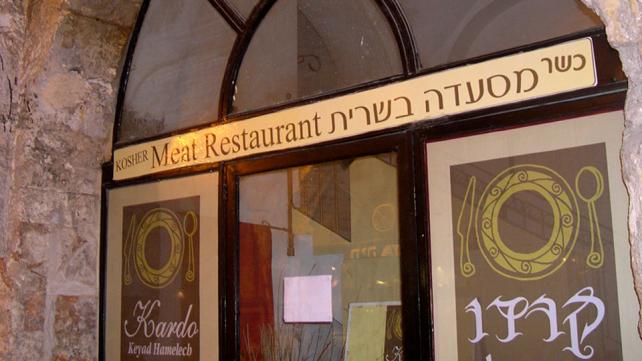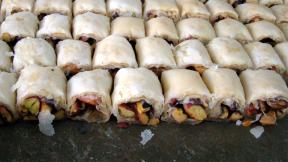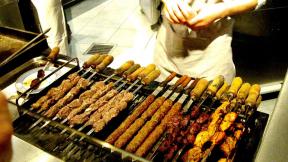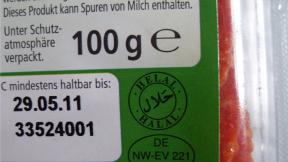
The system of labeling products with Kosher lable goes back at least 100 years in America. Jews who are strict about maintaining Jewish dietary laws need to know which products, both meat and non-meat, are fit for consumption. Kosher label is one major way to determine this.
There are about 500 Kosher certification agencies in the U.S. There are also a number of different Kosher labels.
Sound Vision spoke to Rabbi Moshe Elefant, executive rabbinical coordinator of the Orthodox Union (OU) based in Manhattan, New York to explain his organization's Kosher label system.
Rabbi Elefant administers the OU's worldwide Kosher programs. The OU maintains one of the strictest standards of Kosher as an Orthodox Jewish Organization, although they also serve non-Orthodox Jewish communities.
"We certify 4500 facilities in 68 countries around the world and every one of the 50 states in the United States," he noted in a telephone interview with Sound Vision.
The OU has been doing Kosher labeling for the past 100 years in the US Their first client, Heinz ketchup, is still labeled by them.
The different Kosher labels
The OU's Kosher label is indicated by their initials, but there are other Kosher agencies with different labels as well.
Some of these are: MK, OK (Organized Kashruth) and a star with the letter "K" in it.
The difference in Kosher labeling companies is explained by the fact that "a lot of local Jewish communities have their own rabbinical board," says rabbi Elefant, which determine Kosher standards and have their own symbols.
These labels go not just on meat, but also on everyday items like cereal, for instance. For a product to gain the OU's approval and label, not only does the product itself have to be Kosher, but all ingredients added to it, including flavors must pass the test of Kosher approval.
Difference in understanding of what is "Kosher"
One explanation for the difference in Kosher labels is that there are different views amongst rabbis about what exactly passes as fit for Jewish consumption and what does not.
"There are differences of opinion on the definition of Kosher law," rabbi Elefant notes. "Every rabbi is entitled to interpret the law as he sees correct. Our job as rabbis is to take ancient law and adapt it to modern technology. Obviously when you're doing that there are going to be differences of opinion."
However, he adds that "many of us share the same (Kosher) standard" and emphasized that buyers of Kosher products are the ones who ultimately have to select food based on their understanding of Kosher.
"The consumer is to judge if the supervision on the product meets their level," he says.
How to get Kosher certification for products through the OU
If a company wants Kosher certification from the OU, Rabbi Elefant explained that the process works in the following manner:
- The company must apply to the OU for certification.
- The OU examines if all of the ingredients used are Kosher. This means the following:
- the product cannot mix meat and milk products (so for example, a cheeseburger cannot be Kosher).
- anything that is animal derived in the product has to come from an animal that is slaughtered by a rabbi and also examined for any internal wounds.
- if any part of the product is processed on equipment that also processes non-Kosher material, the product is automatically rendered non-Kosher.
- anything pork related being present in the product automatically makes it non-Kosher.
- The OU dispatches a rabbi to check out a company that has applied for certification. The OU tries to use one of its rabbis to do an initial inspection at the company's facility which is really a feasibility study to determine how the OU can create a Kosher program at the company's facility.
- Once that program is established, a contract is signed whereby the company is now obligated to follow the Kosher standards.
- A rabbi visits the plant on a periodic, unannounced basis to make sure that the company is maintaining Kosher standards. This unannounced visit can happen anywhere from twice a year to everyday. Some plants have full time rabbinical staff.
Kosher meat is much more complicated
Kosher meat on the other hand, is much more complex and the standards are stricter. It is important to note that Jews careful about Jewish dietary laws would not eat meat slaughtered by a non-Jew, even if it was slaughtered in the correct manner because "that's what the rules say," according to Rabbi Elefant.
The process of going from meat to Kosher meat entails the following:
Choosing the right type of animal
The following animals can never be considered Kosher: horse, pig, camel, lions, tiger.
Fish also gain a Kosher designation. All Kosher fish have fins and scales.
Choosing the right person to slaughter the animal
The animal has to be slaughtered in a prescribed manner by a rabbi who is trained in that craft . He is called a Shochet or the ritual slaughterer. He has to be a trained Jewish person.
Slaughtering the animal in the prescribed manner
The process of Kosher slaughter is the following:
First the animal is inspected for any internal wounds. If it has any, then it is not considered Kosher.
If there are no wounds, certain veins which are prohibited by Jewish dietary laws are removed. One example of this is the sciatic nerve, which is located around the thigh.
Once this is done, all blood in the animal is removed. It is forbidden to consume blood. This removal is done through a salting process. The animal is rinsed three times and salted twice.
After this process, the meat can be considered Kosher.
The price of certification
There is no set price for Kosher certification/ Rabbi Elefant says the OU's prices for Kosher certification are based on cost.
The first thing the OU determines is how much it will cost to set up their program in a company that has applied for Kosher certification.
"If you're facilities are in remote areas, you want an agency that can get there and administer the program. Cost is a consideration," explains the rabbi.
In the OU's case, the money generated from certification goes back into the nonprofit organization.
Abuse in the use of Kosher labels
The abuse of the Kosher labels is not uncommon.
"We're a trademark symbol," says Rabbi Elefant of the OU's Kosher label. "No one's allowed to use that symbol without our authorization. Unfortunately it does happen that we do find our symbol used without authorization."
"The first thing we do is that we demand that they (the offending party) cease and desist from using our symbol," he explains. Following this, the OU demands a recall of that product if it is not Kosher. If it is, then in consultation with their lawyers, they determine what to do.
He notes that usually problem is fixed simply. At times it's not that simple, so they have to go court and sue for the misuse of OU's trademark symbol.
Photo Attribution: http://commons.wikimedia.org/wiki/File:Meat_Restaurant_(2793954530).jpg








Comments
If olive oil has a K and not
If olive oil has a K and not * K is it kosher?
Location
Excellent information about kosher certification. I am Jewish and read an article in the local newspaper here about an American woman who married a man from Saudi Arabia. She attended a potluck at his Mosque and brought a "tuna-fish" casserole. Apparently, the potluck attendees were not too thrilled about the tuna fish. The article did not explain why. I asked a local Muslim about this and he explained that pork is sometimes used to flavor tuna fish. That was the first time I ever heard of that. I now make sure that any tuna fish I purchase has a kosher symbol, such as the OU. A final thought: As far as I know, Islam and Judaism are the only religions that have dietary laws.
Location
Can a Muslim eat Kosher meat? It seems to me that they met all the criteria in the Quran.Many thanks to last commentator for "saying a prayer to God" before slaughter. It surprises me that I didn't see that a lot on the internet about Kosher, almost like they are shy about it.
Location
Informative article. Thanks! Also, looks like one step in the kosher slaughtering process was accidentally left off your list. But it's the most important one - the actual slaughter. How it works is that the butcher should take a very sharp knife with no nicks or dents in it and after saying a blessing to God, draw the knife in one rapid painless movement across the jugular (this should be done out of sight of other animals who may be traumatized by the sight.) Then the animal should be hung up to drain as much blood as possible. Then, on to the other steps mentioned in the article.THanks again for the great article!
Location
Add new comment